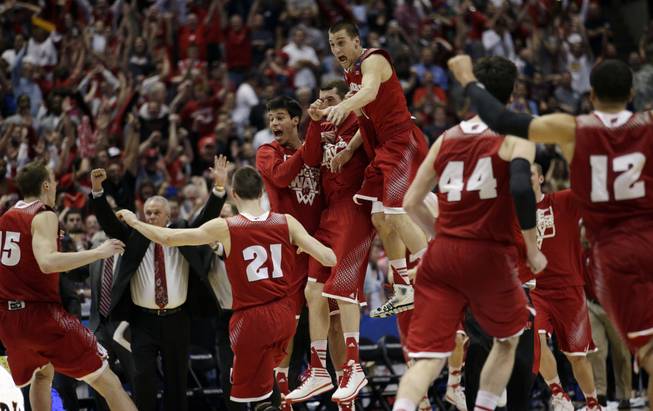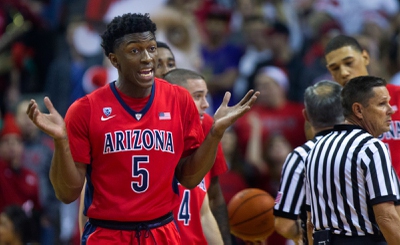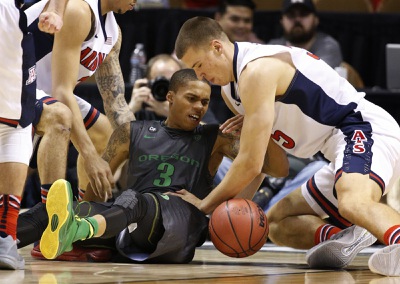
Jae Hong / AP
Wisconsin players react as time runs out in overtime in a regional final NCAA college basketball tournament game, Saturday, March 29, 2014, in Anaheim, Calif. Wisconsin won 64-63 in overtime.
Published Tuesday, March 17, 2015 | 11:30 a.m.
Updated Wednesday, March 18, 2015 | 10:45 a.m.
West Region bets
- Which of these bets would you make on a team to win the West Region?
- Wisconsin 6-to-5 — 44.7%
- Arizona 6-to-5 — 44.7%
- North Carolina 10-to-1 — 4.4%
- Ohio State 20-to-1 — 3.5%
- Baylor 10-to-1 — 1.8%
- Arkansas 25-to-1 — 0.9%
This poll is closed, see Full Results »
Note: This is not a scientific poll. The results reflect only the opinions of those who chose to participate.
Midwest Region 2015
- Which of these teams would you bet to win the Midwest Region?
- Kentucky 1-to-3 — 67.0%
- Notre Dame 8-to-1 — 14.8%
- Kansas 8-to-1 — 6.2%
- Wichita State 8-to-1 — 6.2%
- Maryland 20-to-1 — 3.4%
- West Virginia 30-to-1 — 2.3%
This poll is closed, see Full Results »
Note: This is not a scientific poll. The results reflect only the opinions of those who chose to participate.
Related Coverage
- NCAA Tournament by the odds: How Las Vegas sports books see Midwest Region
- NCAA Tournament opening lines and future odds: Kentucky hides overall parity
- March Madness: Here’s your sports betting cheat sheet
- Mountain West gets 3 teams in, CSU makes history as NCAA Tournament outcast
- Sun's printable NCAA Tournament bracket
- Former Findlay Prep star Brandon Ashley pushes Arizona to Pac-12 tournament title
- Wyoming wins trip to NCAA Tournament in thrilling fashion vs. San Diego State
- Sports section
Note: This is part two of the Sun’s betting previews on the NCAA Tournament. Check out part one, the Midwest Region, here and come back tomorrow for the final two installments.
It’s almost as if the NCAA Tournament selection committee treated the West Region as a pickup game and declared, “run it back.”
The West produced some of the most compelling action of last year’s tourney, largely because of Wisconsin’s 64-63 upset victory over Arizona in the finals and higher-seeded teams featuring alpha dogs with enough bite to keep things interesting earlier.
Winners stayed on the court this year. For just the third time since the field expanded to 64 teams three decades ago, a bracket has the same squads slotted into the top two seeds.
No. 1 seed Wisconsin and No. 2 seed Arizona swapped spots from last year — the committee did the same in the East with No. 1 seed Villanova and No. 2 seed Virginia — but remain on the same path otherwise.
They even picked up four of the same teams that were hanging around last year, including No. 3 seed Baylor, which reached the Sweet 16 by upsetting Creighton as a No. 6 seed.
The venue is almost unchanged too, with the 30-mile move from Anaheim, Calif.’s Honda Center to Los Angeles’ Staples Center akin to switching to a YMCA on a different side of town.
For all the flak the committee gets on an annual basis, this repeat doesn’t appear to have caused as much as a minor stir. Maybe it’s because it always felt like the Badgers and Wildcats had unfinished business. It always felt like they were on another collision course this season.
The two most prominent cardinal-red colored programs in college basketball have shared the top five in sports books’ future odds since the moment the Westgate Las Vegas Superbook posted them last April. Arizona opened as the overall favorite at 6-to-1 back then with Wisconsin filing in at 12-to-1, and they never strayed far for the last 11 months.
Coincidences turned eerie on January 11 when both teams suffered arguably their worst losses. Wisconsin fell on the road to Rutgers 67-62 as 15-point favorites a few hours before Arizona tripped up at Oregon State 58-56 as 10-point favorites.
From there, Arizona went 17-1 and Wisconsin finished 16-1 as the pair won both their conference regular-season and tournament championships. Dedicated college basketball bettors know the biggest difference: Arizona raked in more money.
The Wildcats go into March Madness on a 14-4 against the spread run, bringing their season tally to 22-12 for one of the five best in the tournament. The Badgers were only 8-8-1 against the spread during their streak, adding up to 18-15-1 total.
The covering rally has caught Arizona up with Wisconsin in the betting market. They are the two teams in the tournament that would have the lowest point spreads against Midwest Region behemoth Kentucky, a potential Final Four opponent, at somewhere around six.
The possible Elite Eight matchup between Arizona and Wisconsin would have a line of less than last year’s minus-3.5 too. It wouldn’t take a world-class oddsmaker spying on the blacktop to gather the two teams’ evenly matched nature.
The Badgers return all but one player who stepped onto the floor in last year’s game, which delivered them to the Final Four for the first time in 14 years, including seniors Frank Kaminsky and Traevon Jackson.
Kaminsky, who led Wisconsin with 28 points and 11 rebounds in the victory, is the favorite for National Player of the Year after leading the country in win shares and Player Efficiency Rating this season. Jackson, who paced the team with 10 points and five assists in 40 minutes of action, is coming back from a fractured foot that forced him out of the last 16 games in the tournament.
Arizona lost its two most productive players from the memorable affair to the NBA in Aaron Gordon, who had 18 rebounds, and Nick Johnson, who missed a shot he let go right after the buzzer. But it returns the other four players who logged more than 30 minutes in senior T.J. McConnell, junior Kaleb Tarczewski, junior Gabe York and sophomore Rondae Hollis-Jefferson.
And that list doesn’t include their top two scorers this season. Freshman Stanley Johnson and junior Brandon Ashley have proven as big of game-changers as Woody Harrelson in “White Men Can’t Jump.”
Johnson ranks second to Kaminsky in Ken Pomeroy’s Player of the Year metric. Ashley announced he finally felt 100 percent after a broken foot he suffered last year with most outstanding player honors at the Pac-12 tournament last week at the MGM.
Both teams are equally loaded, which is why the West is the sole region with co-favorites as Arizona and Wisconsin are plus-120 (risking $1 to win $1.20) apiece to reach the Final Four. That implies a 35 percent chance, after adjusting for casinos’ hold percentage, for each team getting to Indianapolis.
The Badgers were ahead of the Wildcats in odds to win the tournament a week ago, 7-to-1 compared to 12-to-1, but the latter trimmed to 8-to-1 by Selection Sunday. It was appropriate when Arizona joined Wisconsin as the 7-to-1 second choice behind Kentucky by Monday afternoon.
There are several vultures lurking around the sidelines of the West Region, however, with hopes of rising above the challenge court and poaching prime position from Arizona or Wisconsin. Some of them are identical to those who were dispatched last year.
Baylor junior forward Rico Gathers played limited action in three NCAA Tournament games in 2014 but now leads the nation in grabbing 22.8 percent of all available rebounds. The Badgers took out Gathers and the Bears 69-52 as 4-point favorites last year only after eliminating Oregon 85-77 as 6-point favorites the round before.
The Ducks are back in the West as a No. 8 seed behind Pac-12 Player of the Year Joseph Young, who dropped 29 points on Wisconsin in the round of 32 loss. The now senior sits fifth in the nation with 688 points this season.
No. 11 seed BYU’s Tyler Haws is one of two players in the tournament to have scored more than Young with 713 points. The Cougars pair the senior Haws with junior Kyle Collinsworth, who set an NCAA record with his sixth triple double in the West Coast Conference tournament at the Orleans two weeks ago.
BYU must get past Ole Miss as 4-point favorites in a First Four game tonight to put itself in a matchup with No. 6 seed Xavier, which could have a curious pairing of its own in the Sweet 16.
Arizona coach Sean Miller left Xavier after leading the team to a second Elite Eight in 2009, but the Musketeeers have done fine without him. They’ve now returned to the tournament in five of the last six years with two Sweet 16 berths and a 5-2-1 against the spread record under Miller’s replacement Chris Mack.
No. 9 seed Oklahoma State are the final repeat invitee to the region party with senior swingman Le’Bryan Nash seeking his elusive first NCAA Tournament win and cover.
The Cowboys are yet another team in a wild west grudge match, having played the Ducks in their first postseason game two years ago and losing 68-55 as 2-point favorites. The line has flipped back and forth for Friday’s game in Omaha, Neb., but Oklahoma State is currently getting a point.
Not all of the West’s most imposing forces are familiar, though. Sophomore power forward Bobby Portis from No. 5 seed Arkansas trailed only Kentucky’s Karl Anthony-Towns for the highest Player Efficiency Rating in the SEC.
The Razorbacks, given just a 3 percent chance to get to the Final Four at 100-to-1, are overseeded by Vegas measures. Their neighbors, No. 4 seed North Carolina, are the opposite.
The Tar Heels have the seventh lowest price to win the tournament at 25-to-1. They’re the most likely side to spoil the Arizona vs. Wisconsin rematch with two rebounders nearly on Gathers’ level in junior Brice Johnson and sophomore Kennedy Meeks.
BYU, North Carolina and Arkansas play faster than any other teams in the tournament, according to Pomeroy’s tempo statistic, to add to the West’s free-flowing feel.
Despite coming in as the largest favorites out of their respective seeds, North Carolina and Arkansas face seasoned mid-major programs to start.
No. 13 seed Harvard, North Carolina’s opponent, has danced four straight years with upsets in each of the last two appearances and an overall 3-2 against the spread record. No. 12 seed Wofford, Arkansas’ foe, hasn’t sprung an upset but the Terriers have advanced to the tournament in four of the last six years and gone 2-1 against the spread in previous outings.
North Carolina and Arkansas will leave the poor-seeding complaints to VCU, which is the only No. 7 seed coming into its first game as an underdog. With their exhausting press and coach Shaka Smart’s 8-3 against the spread record in March Madness, the Rams are usually like the pesky defender at the park who no one wants to match up against.
But there’s a legitimate question as to whether they can phase No. 10 seed Ohio State freshman guard D’Angelo Russell, the projected second pick in the upcoming NBA Draft. The Buckeyes have disappointed with a 23-10 straight-up, 15-16-1 against the spread record but they still deserved closer to a No. 6 seed according to Las Vegas.
Ohio State is 100-to-1 to win the national championship, making it the fifth team in the West at those odds or lower. That’s the fewest true contenders — UConn won the tournament at a 100-to-1 price last year as the longest shot in 30 years — of any region.
But the gripes over unbalanced bracketing have been minimized, possibly with memories of last year’s excitement revolving on the two juggernauts and spunky hopefuls surrounding them playing a factor.
Implementing a shoot for ball policy and rules for teams to call their own fouls is the only way the West Region could get more in the spirit.
Pick to win the region: Arizona at plus-120 I’ll just say it: Arizona is playing better than anyone in the country. Yes, and over the last month or so, that includes Kentucky. The Wildcats are the take at any plus-price. North Carolina at 10-to-1 is almost worth a gamble but I’ll ultimately stick with the team I expect to come out.
West Region Picks Against The Spread (in order of confidence)
Note: It’s a losing long-term strategy to pick every game, but we’ll go for it in the blog anyway and track records through every round. Check back after Tuesday’s first four games for the final pick.
No. 14 seed Georgia State plus-9 vs. No. 3 seed Baylor
No. 9 seed Oklahoma State plus-1.5 vs. No. 8 seed Oregon
No. 12 Wofford plus-8 vs. No. 5 Arkansas
No. 10 seed Ohio State minus-3 vs. No. 7 seed VCU
No. 2 seed Arizona minus-23 vs. No. 15 seed Texas Southern
No. 4 seed North Carolina minus-10 vs. No. 13 seed Harvard
No. 6 seed Xavier minus-2.5 vs. No. 11 seed Ole Miss
No. 11 seed BYU minus-2.5 vs. No. 11 seed Ole Miss
No. 1 seed Wisconsin minus-19.5 vs. No. 16 Coastal Carolina
Case Keefer can be reached at 948-2790 or [email protected]. Follow Case on Twitter at twitter.com/casekeefer.




Join the Discussion:
Check this out for a full explanation of our conversion to the LiveFyre commenting system and instructions on how to sign up for an account.
Full comments policy